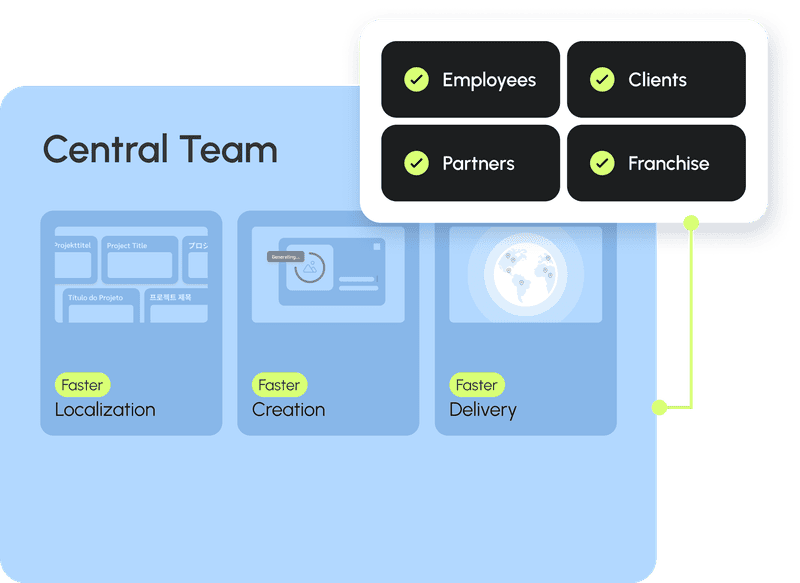If you’re leading a modern enterprise marketing team, you know the tension all too well. You’re under pressure to get campaigns out faster, keep brand guidelines locked in, manage legal and compliance risks, and still make every asset feel human and on-brand. Meanwhile, stakeholders want data-driven proof that your content is moving the needle,across every market, channel, and touchpoint.
Every day, I talk to peers facing the same headache: the content marketing software stack is a patchwork of tools, legacy platforms, and manual workarounds. Requests pile up in inboxes. Brand assets go rogue. Review cycles crawl along at a glacial pace. The result? Missed opportunities, duplicated work, and a creeping sense that your brand is slipping out of your hands.
Let’s get real: the content marketing landscape in 2025 demands more than one-off fixes. It needs enterprise-ready solutions that can flex with the scale, complexity, and speed of our organizations. The good news? The newest generation of content marketing software is finally catching up to our ambitions.
Why traditional content marketing processes are breaking
When I started in enterprise marketing, our “content stack” was a shared drive, a handful of PowerPoint templates, and a long email thread for approvals. Fast forward to now, and even the savviest teams feel stretched. It’s not just about producing more content, it’s about orchestrating hundreds of assets, voices, and regulations,at scale, and at speed.
The pain points are familiar:
- Siloed teams and tools slow everything down: Content is created in isolation by product, regional, or channel teams. Design, copy, and compliance get looped in late, resulting in last-minute fire drills and inconsistent messaging.
- Brand inconsistency creeps in: When everyone’s working from their own version of a template or asset, the brand starts to fragment. I’ve seen sales decks with outdated logos, social posts missing disclosures, and regional teams “tweaking” campaigns to fit local needs, unintentionally diluting the master brand.
- Approval bottlenecks frustrate everyone: Legal, compliance, and risk reviews are often managed in separate systems,or worse, over email. This not only eats up time, but also increases the risk of errors slipping through.
- Visibility is limited, and measurement is painful: Trying to answer “What content is working?” or “Where are our assets being used?” requires hours of manual tracking, spreadsheets, and guesswork.
For IT, compliance, and operations, these inefficiencies aren’t just annoying,they’re risky and costly. When content is scattered, it’s impossible to enforce security, audit trails, or data privacy at the level our organizations demand.
The shift to integrated content marketing software
So, what’s changing in 2025? The answer is simple: enterprise content marketing software is finally closing the gap between creativity and control.
Cloud-native platforms, built for scale, are bringing together everything we need,strategy, creation, collaboration, approval, and analytics,into unified workspaces. These aren’t just prettier dashboards, they’re a new operating system for marketing.
I’ve seen first-hand how these solutions can transform the day-to-day:
- Cross-functional teams move in sync: Writers, designers, legal, and brand managers can work together in real time. No more “version hell” or endless email chains.
- Brand governance is built in, not bolted on: Templates, guidelines, and approval workflows are embedded directly into the creative process. Local teams can self-serve,within guardrails.
- Compliance and risk are addressed upfront: Audit trails, permissions, and automated checks make it easier to launch campaigns that are both creative and compliant.
- Insights drive better decisions: With all your assets and data in one place, you get a holistic view of what’s working, where content is being used, and how teams are performing.
The result? You move faster, with more confidence, and your brand gets stronger,not weaker,with every campaign.
What to look for in enterprise content marketing software
Not all platforms are created equal. As someone who’s made the mistake of picking “the shiny new tool” that fizzled out after a few quarters, I’ve learned to prioritize a few must-haves:
Real-time collaboration across teams
Enterprise marketing is a team sport. Your content marketing software should allow writers, designers, legal, and partners to work together without friction. I’m talking about live editing, in-context comments, and clear version history.
I’ve seen the magic when a product marketer and a compliance officer can resolve feedback in minutes, not days. It’s more than a productivity boost, it’s a culture shift.
Built-in brand control and governance
Templates, digital asset management, and style guides need to be more than afterthoughts. The right solution bakes governance into every step, so local teams can create on-brand content without “going rogue.” The best platforms let you lock down certain elements while giving teams creative freedom where it matters.
This is especially critical for regulated industries, where every asset needs to be tracked, stored, and ready for audit.
Enterprise-grade security and compliance
If you’re working with customer data, confidential product info, or sensitive brand assets, security can’t be a checkbox. Your content marketing software should integrate with your identity provider, support SSO, and meet global compliance standards (GDPR, SOC 2, etc). Audit trails and permission controls aren’t just IT requirements,they’re table stakes for trust.
Seamless integrations with your stack
Nobody wants another silo. Your content marketing platform should play nice with your CRM, CMS, email, analytics, and collaboration tools. The more you can automate handoffs and sync data, the less manual work,and the fewer errors,you’ll face.
I’ve seen teams transform workflows when their content platform “talks” to Salesforce, Adobe Creative Cloud, or Slack. Suddenly, assets flow where they’re needed, and reporting gets a whole lot easier.
Powerful analytics and reporting
Content is only as valuable as its impact. The best software gives you clear, actionable insights: which assets are being used, what’s driving engagement, where bottlenecks are forming. When you can tie content performance to business outcomes, it’s easier to justify investments and optimize your strategy.
The top content marketing software solutions for 2025
Let’s talk specifics. These are the platforms I see leading the charge in 2025, based on real enterprise use cases, industry trends, and the evolving needs of marketing teams. Each brings a different strength to the table,but all are built for scale, security, and brand impact.
- Adobe Experience ManagerWhy it’s a leader: Adobe Experience Manager (AEM) is the gold standard for enterprises managing complex digital ecosystems. Its content management, digital asset management, and workflow automation features are deeply integrated, making it a favorite for global brands with lots of moving parts.
How it solves the pain: AEM lets you centralize content, enforce brand guidelines, and roll out personalized experiences across markets. The platform’s robust approval workflows and compliance tools are particularly valuable for regulated industries like finance and healthcare. Integration with Adobe Creative Cloud means your creative teams can move seamlessly from ideation to execution.
- ContentfulWhy it’s gaining ground: Contentful’s API-first, headless approach makes it a powerhouse for organizations that need to deliver content across channels,web, mobile, apps, IoT, and more. It’s incredibly flexible, which is great for fast-moving teams and complex digital products.
How it solves the pain: Contentful breaks down silos by providing a single source of truth for all your content. Developers love the extensibility, while marketers appreciate the intuitive interface and governance features. It’s ideal for enterprises with a “composable” stack that want to future-proof their digital experiences.
- BynderWhy it’s essential for brand consistency: Bynder is the go-to digital asset management (DAM) platform for brand-centric organizations. Its strength lies in making brand guidelines, templates, and assets accessible (and enforceable) across global teams.
How it solves the pain: With Bynder, you can lock down master templates, distribute on-brand assets, and automate approvals. I’ve seen consumer brands use Bynder to empower local marketing teams to create compliant campaigns quickly, without losing control over the look and feel.
- Welcome (formerly NewsCred)Why it stands out: Welcome is purpose-built for content operations at scale. It brings planning, collaboration, content creation, and analytics into a single platform,helping teams align strategy with execution.
How it solves the pain: Welcome’s editorial calendar, workflow automation, and integrated analytics make it easy to manage complex campaigns with lots of stakeholders. Marketing ops and brand teams get the transparency they need to spot bottlenecks, while creative teams stay focused on what matters.
- SprinklrWhy it’s critical for omnichannel: Sprinklr is the engine behind some of the world’s most sophisticated social and content programs. Its unified platform covers publishing, asset management, listening, and analytics across every major channel.
How it solves the pain: Sprinklr helps enterprise teams keep messaging consistent, monitor brand health, and respond to customer signals in real time. The compliance and approval features are robust, making it a fit for regulated industries and global brands alike.
- DesygnerWhy it’s a new favorite for brand control: Desygner stands out for its user-friendly approach to brand governance. The platform makes it easy for non-designers to create on-brand assets, while giving marketing and compliance teams granular control.
How it solves the pain: Desygner’s template locking, role-based permissions, and audit trails help enterprises speed up content creation without sacrificing brand consistency. I’ve seen financial services teams use Desygner to empower local offices to create compliant, on-brand presentations and marketing materials,cutting turnaround times dramatically.
- Percolate (now part of Seismic)Why it matters for B2B and complex sales: Percolate’s roots in content orchestration make it a strong choice for organizations with long buying cycles and complex stakeholder maps.
How it solves the pain: The platform brings together planning, production, and measurement, making it easier for marketing and sales teams to align. Integration with Seismic’s sales enablement tools means content flows directly into the hands of sellers,always up to date, always on-brand.
- KapostWhy it’s a fit for regulated industries: Kapost is designed for organizations where compliance and content complexity go hand in hand. Its workflow and governance features are particularly strong.
How it solves the pain: Kapost helps you map content to personas, buying stages, and channels,while automating review and approval processes. I’ve seen healthcare and financial services teams use Kapost to ensure every asset meets regulatory requirements, with full audit trails for peace of mind.
The next-gen DAM for enterprise
Get more than just storage. Get the DAM that dramatically improves content velocity and brand compliance.Real-world results: how top brands are scaling content with the right software
Let’s move from features to outcomes. What actually changes when you upgrade your content marketing software? In my experience, it’s not just about faster approvals or prettier dashboards,it’s a step-change in how your entire organization operates.
More campaigns, less chaos
One Fortune 500 technology company I worked with used to spend weeks chasing down approvals for global product launches. After centralizing their content operations in a platform with automated workflows and real-time feedback, they cut campaign launch times by 40 percent. Local teams could customize assets without breaking brand rules, and compliance signoff happened in hours, not days.
Brand consistency, no matter the market
A global consumer brand struggled with regional teams “reinventing the wheel” for every market. By rolling out a DAM and template system, they empowered local marketers to create content that fit cultural nuances,while locking in core brand elements. The result? Stronger brand equity, fewer legal headaches, and a big boost in creative output.
Secure, scalable content operations
In heavily regulated sectors like healthcare and financial services, security and auditability are non-negotiable. A large insurer I advised adopted an enterprise-grade content platform with granular permissions and full audit trails. This enabled them to accelerate content creation for new products,while staying fully compliant with industry regulations.
Better data, smarter decisions
When all your content, assets, and analytics live in one system, you finally get the visibility you need. I’ve seen marketing ops leaders move from reactive reporting to proactive optimization,spotting which assets drive engagement, where bottlenecks form, and how to allocate resources for the biggest impact.
Overcoming adoption hurdles and driving change
Of course, no software is a silver bullet. I’ve lived through “big bang” rollouts that fizzled out because teams weren’t bought in, or the platform didn’t fit real workflows. The trick is to focus on change management as much as technology.
Start with the pain, not the pitch
When evaluating new content marketing software, start by mapping your team’s biggest headaches. Where are the delays, errors, or risks? Let the pain points drive the requirements,not the other way around. Bring legal, compliance, IT, and local markets into the process early. Their input is critical for adoption.
Design for how teams really work
Look for platforms that fit your organization’s reality. If your teams are distributed, prioritize real-time collaboration and flexible permissions. For highly regulated industries, audit trails and policy enforcement should be front and center. The best software adapts to your workflow, not the other way around.
Invest in enablement and support
Rolling out new content marketing software isn’t just an IT project. It’s a shift in how your teams create, share, and measure content. Invest in onboarding, training, and ongoing support. Celebrate quick wins, gather feedback, and iterate as you go. The more you empower your teams, the faster they’ll embrace the change.
Measure, optimize, and evolve
Set clear success metrics up front,whether that’s faster turnaround times, higher asset reuse, or reduced compliance risk. Use the platform’s analytics to track progress, spot bottlenecks, and make data-driven improvements. Content marketing is never “done,” and neither is your stack.
Bringing it all together: the future of content marketing software in enterprise
As we look ahead to 2025 and beyond, the stakes are only getting higher. Audiences expect personalized, timely, and authentic content,delivered across more channels than ever. Regulators are raising the bar for compliance and data privacy. And internal stakeholders demand proof that every dollar spent on content drives real business impact.
The right content marketing software isn’t just a productivity hack,it’s a strategic advantage. It’s how you move at the speed of culture without sacrificing control. It’s how you give creative teams the freedom to experiment, while ensuring every asset strengthens your brand. It’s how you turn content from a cost center into a growth engine.
I’ve seen what’s possible when enterprise teams make the leap. Campaigns launch faster. Brands stay stronger. Risks go down, and impact goes up. The path isn’t always easy, but with the right tools,and the right mindset,you can build a content operation that’s as agile, secure, and scalable as your business demands.
Enterprise marketing has never been more complex or more critical to business success. As we head into 2025, the pressure to deliver more content, faster, and with greater precision is only intensifying. The old way,patching together disconnected tools and manual processes,simply can’t keep up with the demands of brand consistency, compliance, and speed-to-market. That’s why investing in the right content marketing software is no longer a nice-to-have, it’s a strategic imperative. The newest generation of platforms is built for the realities of modern enterprise: they’re secure, scalable, and designed to empower cross-functional teams to do their best work without sacrificing control.
The key is to focus on solutions that fit your organization’s unique needs, workflows, and risk profile. Look for platforms that offer real-time collaboration, robust governance, seamless integrations, and actionable analytics. Bring your IT, legal, and compliance teams into the conversation early, and prioritize change management alongside technology. When you get it right, the payoff is huge: faster launches, fewer errors, stronger brands, and measurable impact across every channel. In 2025, the best content marketing software will be the backbone of every successful enterprise strategy,helping you meet the moment, stay ahead of the curve, and turn content into your most powerful asset.







